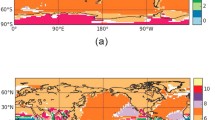Abstract
We consider climate networks constructed from observed and model simulated fields of three climate variables and investigate their community structure. We find that for all fields the number of effective communities is rather small (four to five). We are able to trace the origin of these communities to certain dynamical properties of climate. Our results suggest that the complete complexity of the climate system condenses beyond the ‘weather’ time scales into a small number of low-dimensional interacting components and provide clues as to the nature of the climate subsystems underlying these components.




Similar content being viewed by others
References
Albert R, Barabasi A-L (2002) Statistical mechanics of complex networks. Rev Mod Phys 74:1–54
Ambaum MHP, Hoskins BJ, Stephenson DB (2001) Arctic oscillation or North Atlantic oscillation? J Clim 14:3495–3507
Arenas A, Diaz-Guilera A, Perez-Vicente CJ (2006) Synchronization reveals topological scales in complex networks. Phys Rev Lett 96:114102
Barnston AG, Livezey RE (1987) Classification, seasonality, and persistence of low-frequency atmospheric circulation patterns. Mon Wea Rev 115:1083–1126
da F. Costa L, Rodrigues FA, Travieso G, Villas Boas PR (2007) Characterization of complex networks: a survey of measurements. Adv Phys 56:167–242
Eichler T, Higgins RW (2006) Climatology and ENSO-related variability of North American extratropical cyclone activity. J Clim 19:2076–2093
Elsner JB, Jagger TH, Fogarty EA (2009) Visibility network of United States hurricanes. Geophys Res Lett 36:L16702. doi:10.1029/2009GL039129
Farkas IJ, Jeong H, Vicsek T, Barabási A-L, Oltvai ZN (2003) The topology of the transcription regulatory network in the yeast Saccharomyces cerevisiae. Physica A 318:601–612
Favre A, Gershunov A (2006) Extra-tropical cyclonic/anticyclonic activity in North-Eastern Pacific and air temperature extremes in Western North America. Clim Dyn 26:617–629
Favre A, Gershunov A (2009) North Pacific cyclonic and anticyclonic transients in a global warming context: possible consequences for Western North American daily precipitation and temperature extremes. Clim Dyn 32:969–987
GFDL CM2.1 development team (2006) GFDL’s CM2 global coupled models, parts 1–4. J Clim 19:643–740
Girvan M, Newman MEJ (2002) Community structure in social and biological networks. Proc Natl Acad Sci USA 99:7821–7826
Gozolchiani A, Yamasaki K, Gazit O, Havlin S (2008) Pattern of climate network blinking links follow El Nino events. Europhys Lett 83:28005
Guimera R, Amaral LAN (2005) Functional cartography of complex metabolic networks. Nature 433:895–900
Hack JJ, Kiehl JT, Hurrell JW (1998) The hydrologic and thermodynamic characteristics of NCAR CCM3. J Clim 11:1179–1206
Held IM, Ting M, Wang H (2002) Northern winter stationary waves: theory and modeling. J Clim 15:2125–2144
Hofman JM, Wiggins CH (2008) A Bayesian approach to network modularity. Phys Rev Lett 100:258701
Holme P, Huss M, Jeong H (2003) Subnetwork hierarchies of biochemical pathways. Bioinformatics 19:532–543
Kistler R et al (2001) The NCEP/NCAR 50-year reanalysis: monthly means, CD-ROM and documentation. Bull Am Meteorol Soc 82:247–267
Lorenz EN (1991) Dimension of weather and climate attractors. Nature 353:241–244
Mantegna RN (1999) Hierarchical structure in financial markets. Eur Phys J B 11:193–197
Mantua NJ, Hare SR, Zhang U, Wallace JM, Francis RC (1997) A Pacific interdecadal climate oscillation with impacts on salmon productions. Bull Am Meteor Soc 78:1069–1079
Newman MEJ (2006) Modularity and community structure in networks. Proc Natl Acad Sci USA 103:8577–8582
Newman MEJ, Girvan M (2004) Finding and evaluating community structure in networks. Phys Rev E 69:026113
Strogatz SH (2001) Exploring complex networks. Nature 410:268–276
Swanson KL, Tsonis AA (2009) Has the climate recently shifted? Geophys Res Lett 36:L06711. doi:10.1029/2008GL037022
Thompson DWJ, Wallace JM (1998) The Arctic Oscillation signature in the wintertime geopotential height and temperature fields. Geophys Res Lett 25:1297–1300
Tsonis AA (1992) Chaos: from theory to applications. Plenum, NY
Tsonis AA (2001) The impact of nonlinear dynamics in the atmospheric sciences. Int J Bifurcat Chaos 11:881–902
Tsonis AA, Elsner JB (1989) Chaos, strange attractors and weather. Bull Am Meteorol Soc 70:16–23
Tsonis AA, Elsner JB (1996) Mapping the channels of communication between the tropics and higher latitudes in the atmosphere. Physica D 92:237–244
Tsonis AA, Swanson KL (2008) Topology and predictability of El Nino and La Nina networks. Phys Rev Lett 100:228502
Tsonis AA, Swanson KL, Roebber PJ (2006) What do networks have to do with climate? Bull Am Meteorol Soc. doi:10.1175/BAMS-87-5-585
Tsonis AA, Swanson KL, Kravtsov S (2007) A new dynamical mechanism for major climate shifts. Geophys Res Lett 34:L13705. doi:10.1029/2007GL030288
Tsonis AA, Swanson KL, Wang G (2008) On the role of atmospheric teleconnection in climate. J Clim 21:2990–3001
Wallace JM, Gutzler DS (1981) Teleconnections in the geopotential height field during the northern hemisphere winter. Mon Wea Rev 109:784–812
Wang H, Fu R (2000) Influence of ENSO SST anomalies and water storm-tracks on the interannual variability of the upper tropospheric water vapor over the Northern Hemisphere extratropics. J Clim 13:59–73
Webster PJ, Holton JR (1982) Wave propagation through a zonally varying basic flow: the influences of mid-latitude forcing in the equatorial regions. J Atmos Sci 39:722–733
Yamasaki K, Gozolchiani A, Havlin S (2008) Climate networks around the globe are significantly affected by El Nino. Phys Rev Lett 100:228501
Acknowledgments
Kyle Swanson and Anastasios Tsonis are funded by NSF grant AGS-0902564. Geli Wang is funded by NSFC 40890052. Luciano da F. Costa thanks CNPq (301303/06-1) and FAPESP (05/00587-5) for sponsorship. Francisco Aparecido Rodriges is grateful to FAPESP (07/50633-9).
Author information
Authors and Affiliations
Corresponding author
Rights and permissions
About this article
Cite this article
Tsonis, A.A., Wang, G., Swanson, K.L. et al. Community structure and dynamics in climate networks. Clim Dyn 37, 933–940 (2011). https://doi.org/10.1007/s00382-010-0874-3
Received:
Accepted:
Published:
Issue Date:
DOI: https://doi.org/10.1007/s00382-010-0874-3




